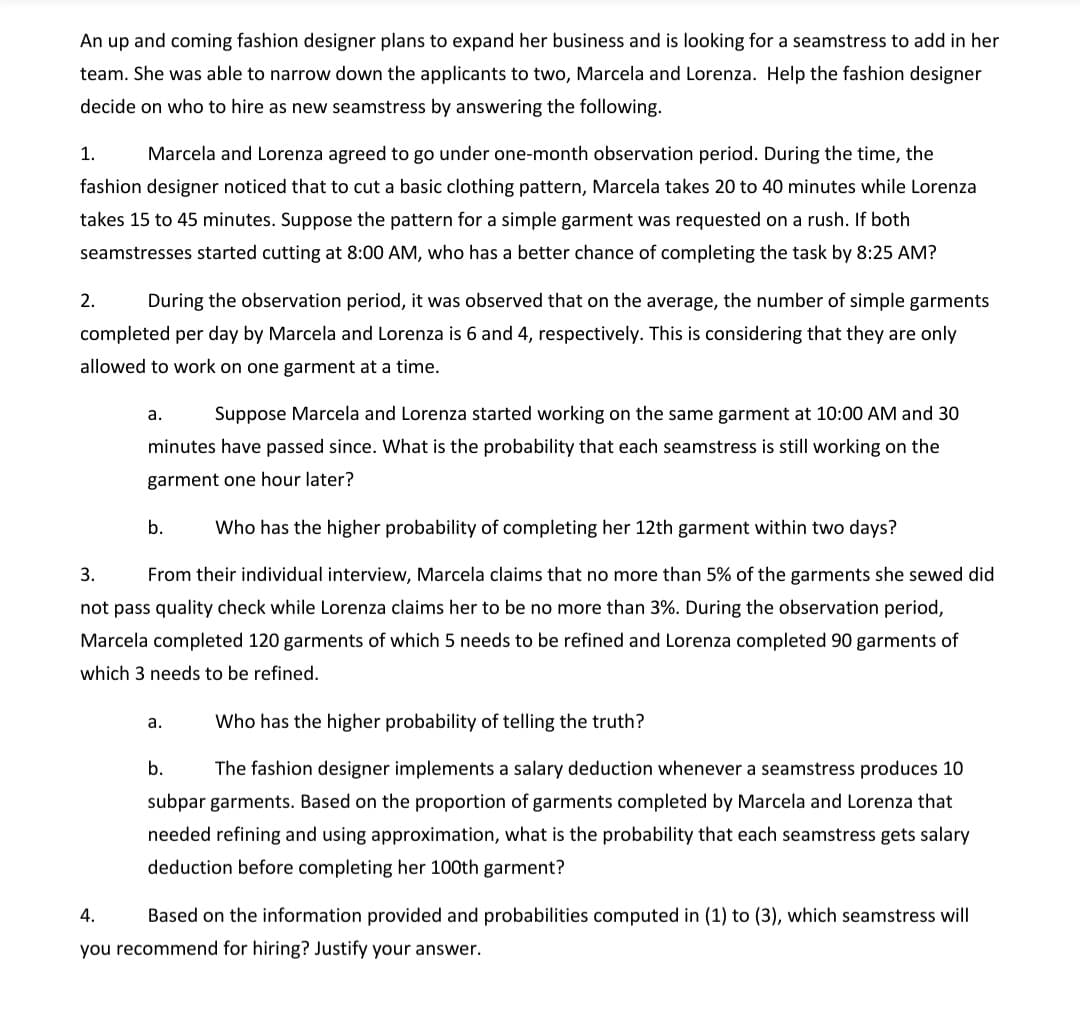From their individual interview, Marcela claims that no more than 5% of the garments she sewed did not pass quality check while Lorenza claims her to be no more than 3%. During the observation period, Marcela completed 120 garments of which 5 needs to be refined and Lorenza completed 90 garments of which 3 needs to be refined. а. Who has the higher probability of telling the truth? b. The fashion designer implements a salary deduction whenever a seamstress produces 10 subpar garments. Based on the proportion of garments completed by Marcela and Lorenza that needed refining and using approximation, what is the probability that each seamstress gets salary deduction before completing her 100th garment? 3.
From their individual interview, Marcela claims that no more than 5% of the garments she sewed did not pass quality check while Lorenza claims her to be no more than 3%. During the observation period, Marcela completed 120 garments of which 5 needs to be refined and Lorenza completed 90 garments of which 3 needs to be refined. а. Who has the higher probability of telling the truth? b. The fashion designer implements a salary deduction whenever a seamstress produces 10 subpar garments. Based on the proportion of garments completed by Marcela and Lorenza that needed refining and using approximation, what is the probability that each seamstress gets salary deduction before completing her 100th garment? 3.
Chapter9: Sequences, Probability And Counting Theory
Section9.5: Counting Principles
Problem 52SE: A car wash offers the following optional services to the basic wash: clear coat wax, triple foam...
Related questions
Question
Answer no. 3 only. I'll upvote
Thank you. Typewritten please.

Transcribed Image Text:An up and coming fashion designer plans to expand her business and is looking for a seamstress to add in her
team. She was able to narrow down the applicants to two, Marcela and Lorenza. Help the fashion designer
decide on who to hire as new seamstress by answering the following.
1.
Marcela and Lorenza agreed to go under one-month observation period. During the time, the
fashion designer noticed that to cut a basic clothing pattern, Marcela takes 20 to 40 minutes while Lorenza
takes 15 to 45 minutes. Suppose the pattern for a simple garment was requested on a rush. If both
seamstresses started cutting at 8:00 AM, who has a better chance of completing the task by 8:25 AM?
2.
During the observation period, it was observed that on the average, the number of simple garments
completed per day by Marcela and Lorenza is 6 and 4, respectively. This is considering that they are only
allowed to work on one garment at a time.
а.
Suppose Marcela and Lorenza started working on the same garment at 10:00 AM and 30
minutes have passed since. What is the probability that each seamstress is still working on the
garment one hour later?
b.
Who has the higher probability of completing her 12th garment within two days?
3.
From their individual interview, Marcela claims that no more than 5% of the garments she sewed did
not pass quality check while Lorenza claims her to be no more than 3%. During the observation period,
Marcela completed 120 garments of which 5 needs to be refined and Lorenza completed 90 garments of
which 3 needs to be refined.
а.
Who has the higher probability of telling the truth?
b.
The fashion designer implements a salary deduction whenever a seamstress produces 10
subpar garments. Based on the proportion of garments completed by Marcela and Lorenza that
needed refining and using approximation, what is the probability that each seamstress gets salary
deduction before completing her 100th garment?
4.
Based on the information provided and probabilities computed in (1) to (3), which seamstress will
you recommend for hiring? Justify your answer.
Expert Solution
This question has been solved!
Explore an expertly crafted, step-by-step solution for a thorough understanding of key concepts.
Step by step
Solved in 3 steps

Recommended textbooks for you


Mathematics For Machine Technology
Advanced Math
ISBN:
9781337798310
Author:
Peterson, John.
Publisher:
Cengage Learning,

Algebra and Trigonometry (MindTap Course List)
Algebra
ISBN:
9781305071742
Author:
James Stewart, Lothar Redlin, Saleem Watson
Publisher:
Cengage Learning


Mathematics For Machine Technology
Advanced Math
ISBN:
9781337798310
Author:
Peterson, John.
Publisher:
Cengage Learning,

Algebra and Trigonometry (MindTap Course List)
Algebra
ISBN:
9781305071742
Author:
James Stewart, Lothar Redlin, Saleem Watson
Publisher:
Cengage Learning

Algebra: Structure And Method, Book 1
Algebra
ISBN:
9780395977224
Author:
Richard G. Brown, Mary P. Dolciani, Robert H. Sorgenfrey, William L. Cole
Publisher:
McDougal Littell

College Algebra
Algebra
ISBN:
9781305115545
Author:
James Stewart, Lothar Redlin, Saleem Watson
Publisher:
Cengage Learning